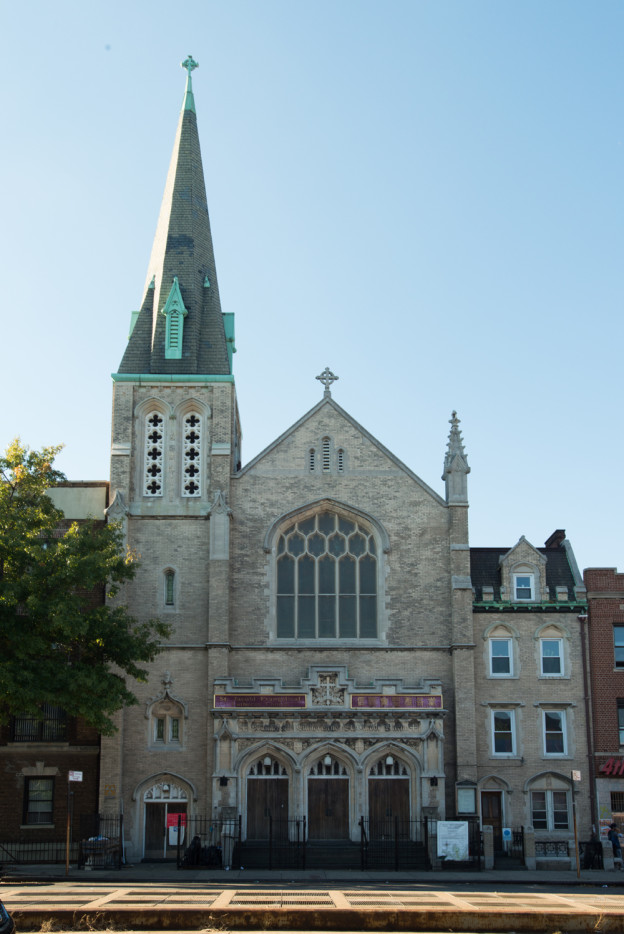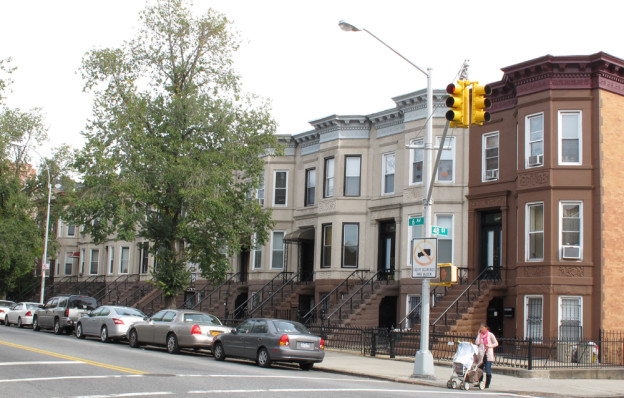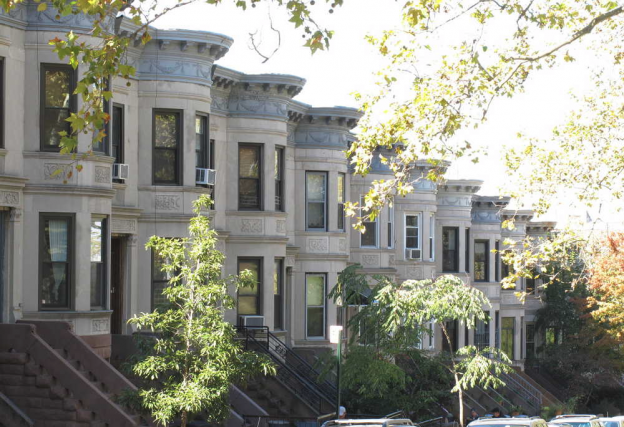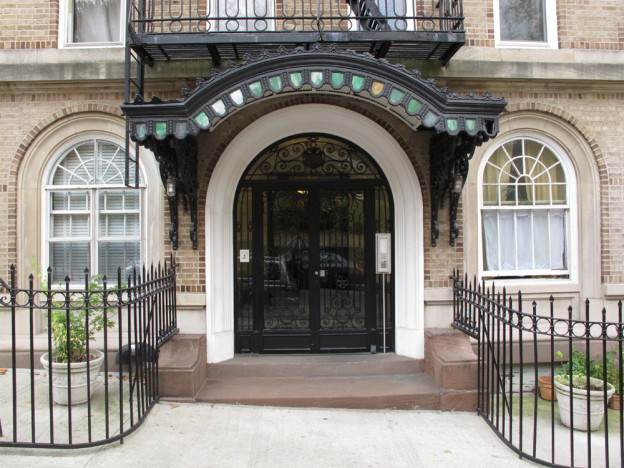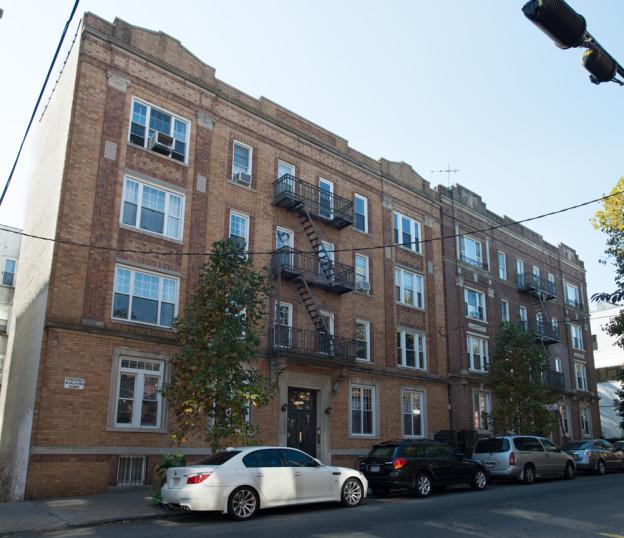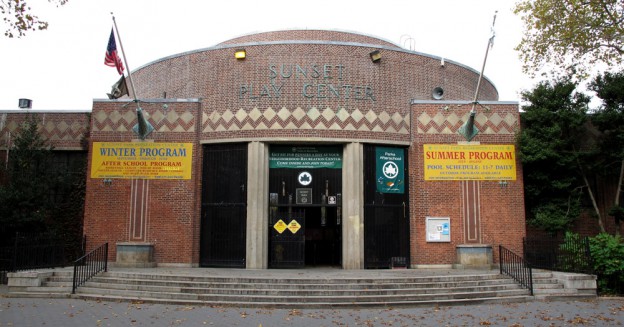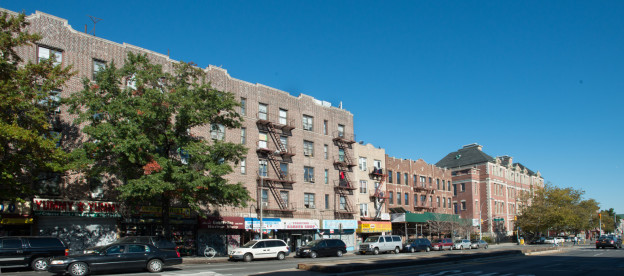404 55th Street;
Harde & Short;
1907|
The neighborhood’s only freestanding mansion originally belonged to the director of the nearby Bay Ridge Savings Bank. The Renaissance Revival brick structure with a rusticated limestone base was designed by Harde & Short, a prestigious firm that was also responsible for many grand apartment houses, including the fanciful, terra-cotta-adorned Alwyn Court on Seventh Avenue and West 58th Street in Manhattan.
5323 Fourth Avenue;
Harold T. Brinkerhoff, 1927-28;
5406 Fourth Avenue 1908-10|
On the corner of 54th Street and Fourth Avenue are two magnificent Lutheran churches designed in the Gothic Revival style. The former Evangelical Lutheran Church of the Incarnation features red and orange brick with cast stone trim and a large pointed-arch stained-glass window dominating its Fourth Avenue façade. The building next door, which is part of the complex, was the congregation’s original church, designed by Bannister & Shell and built in 1908. St. Jacobi, which once offered services in German for area immigrants, features beige brick, a pyramidal spire with copper dormers and a grand crenellated entry with three pointed-arch doorways.
4917 Fourth Avenue;
Lawrence B. Valk & Son;
1893|
This Romanesque Revival church is Sunset Park’s oldest church. Valk was a prolific designer of churches throughout the United States, many in this same Romanesque style. The church is graced with many unusual and charming features, including the arches of varying heights and widths on the front façade and a skinny column running up the side of its bell tower, capped with a small turret and modest cross.
Henry Pohlman of Pohlman & Patrick;
1904|
This lovely row of Renaissance Revival houses between 47th and 48th Street Streets also employs limestone cladding and features elegant carvings, including a dragon-like motif, projecting bays and columns around its entryways. To break up the repetition, Pohlman clad the houses on either end in brownstone, creating a “bookend” effect. Walk along the pretty blocks on 47th or 48th Street toward Fourth Avenue to get to St. Andrew’s Episcopal Church, 4917 Fourth Avenue.
Thomas Bennett;
1908|
Distinctive rowhouses line both Sixth Avenue and its side streets in this part of Sunset Park. This row of Renaissance Revival limestone houses forms an elegant streetscape sloping down the hill from Sixth Avenue. Limestone experienced a surge in popularity after the 1893 World Columbian Exposition in Chicago, which was dubbed “the white city” for its use of light stone cladding. The exposition made a great impression on American architects, including Thomas Bennett, who resided in Sunset Park and designed over 600 rowhouses in the area.
Eisenla & Carlson;
1913-14|
In addition to the construction of new apartment buildings for cooperative ownership, the Finnish Home Building Association purchased already-built apartment houses and converted them into co-ops. These four buildings on the south side of Sunset Park are also outstanding in their architectural details, which include Beaux Arts ornament, ornate brickwork, and beautifully detailed iron and glass canopies on numbers 566 and 570.
816 & 826 43rd Street;
Eric O. Holmgren;
1916-17|
In 1916, 16 families formed the Finnish Home Building Association and broke ground on two cooperative apartment buildings, Alku (meaning “beginning”), and Alku Toinen (toinen meaning “two”), the nation’s first non-profit, cooperatively-owned apartment buildings. At the time, the concept was so new that the state classified the buildings under the Department of Agriculture, which regulated cooperative farms, rather than as housing. Roughly 10 years later, Sunset Park became home to Brooklyn’s “Finntown”, with roughly 50 more co-op apartment buildings and a cooperative shopping complex.
Seventh Avenue between 41st and 44th Streets;
Herbert Magoon with Aymar Embury II, Harry Ahrens and others;
1934-36|
In 1891, the city of Brooklyn, planning for future growth, set aside 14 acres for Sunset Park, which was enlarged to 24.5 acres in 1903. The park affords views of Manhattan, New York Harbor and, more locally, St. Michael’s tower. At the park’s eastern edge, the play center was one of several built across the city during the Great Depression by the Works Progress Administration. The facility was constructed of low-cost brick and cast concrete and employed details characteristic of the Art Moderne style, including sleek curvilinear forms, decorative brickwork and diamond-patterned cast stone. The bathhouse features a one-and-a-half-story center rotunda flanked by corner piers and lined with stacked cylindrical brick walls.
Eisenla & Carlson;
1912-13|
With increased demand for housing after the arrival of the subway, there was a push to construct larger, multi-family dwellings in Sunset Park. This row of three-story tenements contained two apartments per floor, housing six families each. The Renaissance Revival brick tenements feature gabled pediments, accentuated bays, limestone trim and rusticated stone entryways.
Before walking north to 40th Street, peek down 43rd Street between Fourth and Fifth Avenues at the brownstone rowhouses (circa 1898-1904) that form a topographically elegant streetscape. In the 1890s, Fourth Avenue was planned as a “parkway” to South Brooklyn, with planted malls down its center, much like Park Avenue in Manhattan. Unfortunately, the malls were demolished when the subway arrived in Sunset Park in 1915 to make way for vents. Until the 1950s, when car ownership and vehicular traffic were on the rise, Fourth Avenue’s sidewalks were roughly eight feet wider than they are today, to accommodate the popular 19th and early 20th century pastime of “promenading.” The east side of the Avenue is in the National Register historic district.



